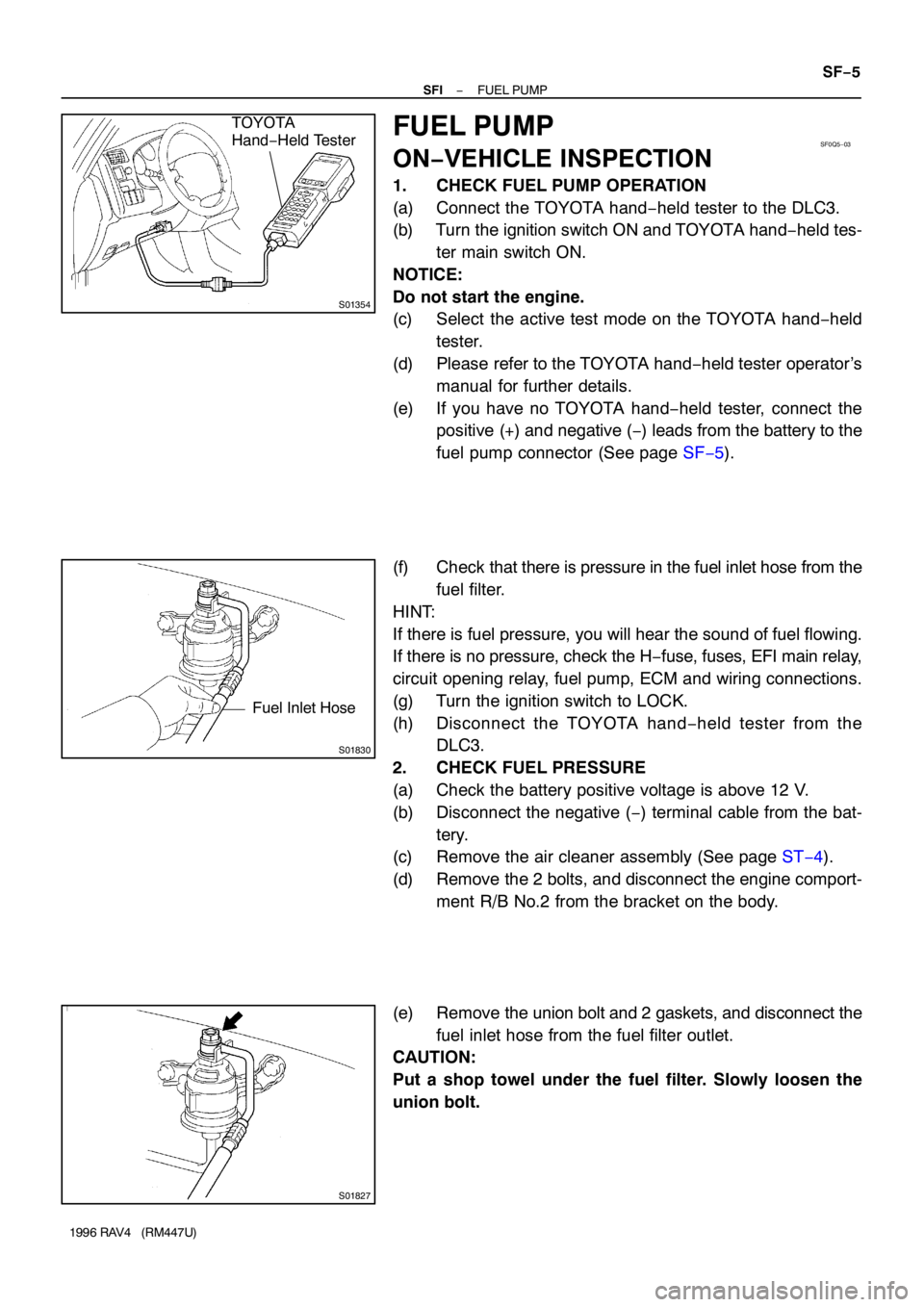Page 313 of 1354

S01294
CO0BS−03
S01279
Disconnect
S01277
93°C
S01290
Ammeter
Battery
S01291
Ammeter
Battery CO−18
− COOLINGELECTRIC COOLING FAN
1996 RAV4 (RM447U)
ELECTRIC COOLING FAN
ON−VEHICLE INSPECTION
1. CHECK COOLING FAN OPERATION WITH LOW TEM-
PERATURE (Below 83°C (181°F))
(a) Turn the ignition switch ON.
(b) Check that the cooling fan stops.
If not, check the cooling fan relay and ECT switch, and check
for a separated connector or severed wire between the cooling
fan relay and ECT switch.
(c) Disconnect the ECT switch connector.
(d) Check that the cooling fan rotates.
If not, check the fan main relay, cooling fan relay, cooling fan,
fuses, and check for short circuit between the cooling fan relay
and ECT switch.
(e) Reconnect the ECT switch connector.
2. CHECK COOLING FAN OPERATION WITH HIGH TEM-
PERATURE (Above 93°C (199°F))
(a) Start the engine, and raise coolant temperature to above
93°C (199°F).
(b) Check that the cooling fan rotates.
If not, replace the ECT switch.
3. INSPECT NO.1 COOLING FAN
(a) Disconnect the cooling fan connector.
(b) Connect battery and ammeter to the cooling fan connec-
tor.
(c) Check that the cooling fan rotates smoothly, and check
the reading on the ammeter.
Standard amperage: 10.9 − 13.9 A
(d) Reconnect the cooling fan connector.
4. INSPECT NO.2 COOLING FAN
(a) Disconnect the cooling fan connector.
(b) Connect battery and ammeter to the cooling fan connec-
tor.
(c) Check that the cooling fan rotates smoothly, and check
the reading on the ammeter.
Standard amperage: 9.1 − 11.1 A
(d) Reconnect the cooling fan connector.
Page 617 of 1354

N17894
Cruise Control
Actuator
457
16 IB2 STOP FuseStop Light SwitchCruise Control ECU
STP−
L
L− 26 1016 1
3 4 2
G−W
G−B
L−B L−B R−Y
R−Y R−W
GNDL
IB2 DI−340
− DIAGNOSTICSCRUISE CONTROL SYSTEM
1996 RAV4 (RM447U)
DTC 12 Actuator Magnetic Clutch Circuit
CIRCUIT DESCRIPTION
This circuit turns on the magnetic clutch inside the actuator during cruise control operation according to the
signal from the ECU. If a malfunction occurs in the actuator or vehicle speed sensor, etc. during cruise con-
trol, the rotor shaft between the motor and control plate is released.
When the brake pedal is depressed, the stop light switch turns on, supplying electrical power to the stop light.
Power supply to the magnetic clutch is mechanically cut and the magnetic clutch is turned OFF.
When driving downhill, if the vehicle speed exceeds the set speed by 15 km/h (9 mph), the ECU turns the
magnetic clutch OFF. If the vehicle speed later drops to within 10 km/h (6 mph) above the set speed, then
cruise control at the set speed is resumed.
DTC No.Detection ItemTrouble Area
12�Short in magnetic clutch circuit
�Open (0.8 sec.) in magnetic clutch circuit
�Cruise contorl actuator magnetic clutch
�Harness or connector between ECU and magnetic clutch,
magnetic clutch and body ground
�ECU
�STOP Fuse
WIRING DIAGRAM
DI42O−02
Page 628 of 1354
N17898
Ignition
SwitchSTOP FuseStop Light
SwitchCruise Control
ECU
STP−
L
L−
GNDL5
47 211
1F1I
IB2
IB2 16
L−BG−B10
2616 1
3 42
R−W R−WJ/B No.1
R−Y
L−BG−W
R−Y
10 A
Cruise Control
Actuator
− DIAGNOSTICSCRUISE CONTROL SYSTEM
DI−351
1996 RAV4 (RM447U)
Stop Light Switch Circuit
CIRCUIT DESCRIPTION
When the brake is on, battery positive voltage normally applies through the stop fuse and stop light switch
to terminal STP− of the ECU, and the ECU turns the cruise control off.
A fail−safe function is provided so that cancel functions normally, even if there is a malfunction in the stop
light signal circuit.
If the harness connected to terminal STP− has an open, terminal STP− will have battery positive voltage and
the cruise control will be turned off, also SET not occurring.
Also, when the brake is on, the magnetic clutch is cut electrically by the stop light switch, turning the cruise
control off. (See page DI−338 for operation of the magnetic clutch)
WIRING DIAGRAM
DI42S−02
Page 778 of 1354
* The system shown here is an EXAMPLE ONLY. It is different to the actual circuit shown in the SYSTEM CIRCUITS SECTION.
H POWER SOURCE (Current Flow Chart)
The chart below shows the route by which current flows from the battery to each electrical source (Fusible Link, Circuit
Breaker, Fuse, etc.) and other parts.
The next page and following pages show the parts to which each electrical source outputs current.
POWER SOURCE
8
B HOW TO USE THIS MANUAL
The Current Flow Chartº section, describes which parts each power source (fuses, fusible links, and circuit breakers)
transmits current to. In the Power Source circuit diagram, the conditions when battery power is supplied to each system are
explained. Since all System Circuit diagrams start from the power source, the power source system must be fully understood.
Page 1219 of 1354

S01354
TOYOTA
Hand−Held Tester
SF0Q5−03
S01830
Fuel Inlet Hose
S01827
− SFIFUEL PUMP
SF−5
1996 RAV4 (RM447U)
FUEL PUMP
ON−VEHICLE INSPECTION
1. CHECK FUEL PUMP OPERATION
(a) Connect the TOYOTA hand−held tester to the DLC3.
(b) Turn the ignition switch ON and TOYOTA hand−held tes-
ter main switch ON.
NOTICE:
Do not start the engine.
(c) Select the active test mode on the TOYOTA hand−held
tester.
(d) Please refer to the TOYOTA hand−held tester operator’s
manual for further details.
(e) If you have no TOYOTA hand−held tester, connect the
positive (+) and negative (−) leads from the battery to the
fuel pump connector (See page SF−5).
(f) Check that there is pressure in the fuel inlet hose from the
fuel filter.
HINT:
If there is fuel pressure, you will hear the sound of fuel flowing.
If there is no pressure, check the H−fuse, fuses, EFI main relay,
circuit opening relay, fuel pump, ECM and wiring connections.
(g) Turn the ignition switch to LOCK.
(h) Disconnect the TOYOTA hand−held tester from the
DLC3.
2. CHECK FUEL PRESSURE
(a) Check the battery positive voltage is above 12 V.
(b) Disconnect the negative (−) terminal cable from the bat-
tery.
(c) Remove the air cleaner assembly (See page ST−4).
(d) Remove the 2 bolts, and disconnect the engine comport-
ment R/B No.2 from the bracket on the body.
(e) Remove the union bolt and 2 gaskets, and disconnect the
fuel inlet hose from the fuel filter outlet.
CAUTION:
Put a shop towel under the fuel filter. Slowly loosen the
union bolt.